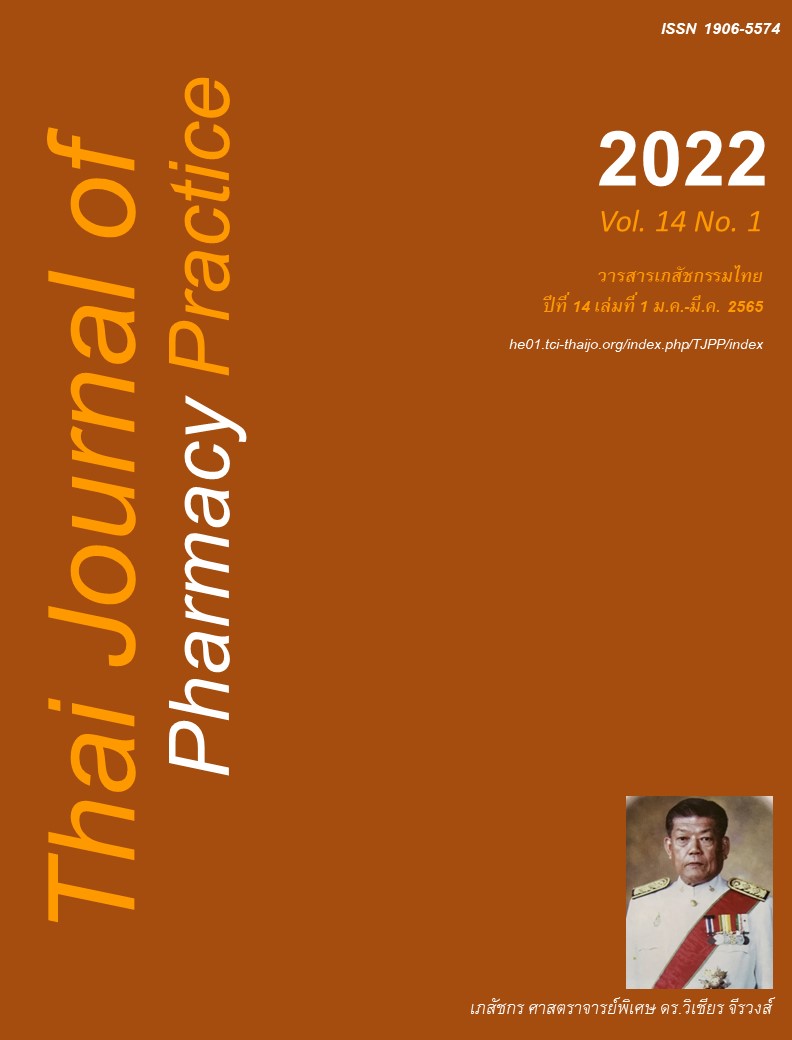ผลการพัฒนากระบวนการประสานรายการยาด้วยระบบอิเล็กทรอนิกส์ ระหว่างโรงพยาบาลและหน่วยบริการปฐมภูมิ ณ อำเภอภูหลวง
Main Article Content
บทคัดย่อ
วัตถุประสงค์: เพื่อสร้างและประเมินชุดคำสั่งอิเล็กทรอนิกส์ในกระบวนการประสานรายการยาสำหรับผู้ป่วยในระหว่างโรงพยาบาลและหน่วยบริการปฐมภูมิ วิธีการศึกษา: การศึกษากึ่งทดลองในโรงพยาบาลชุมชนขนาด 30 เตียง แบ่งเป็น 3 ระยะคือ 1) การวางแผนและวิเคราะห์สถานการณ์และปัญหาของกระบวนการประสานรายการยา 2) การพัฒนาระบบและกระบวนการของการประสานรายการยาและทดสอบระบบ และ 3) การนำระบบลงสู่การปฏิบัติ ประเมินผล และเปรียบเทียบผลก่อนหลังพัฒนาการมีกระบวนการประสานรายการยาด้วยระบบอิเล็กทรอนิกส์ในกลุ่มผู้ป่วยโรคเบาหวานหรือความดันโลหิตสูงหรือโรคร่วมอื่น ๆ ที่เข้ารับการรักษาในโรงพยาบาลและดูแลต่อเนื่องในหน่วยบริการปฐมภูมิ ผลการศึกษา: ผู้ป่วยเข้ารับการรักษาก่อนและหลังการปรับปรุงกระบวนการกลุ่มละ 104 ครั้ง หลังการพัฒนากระบวนการประสานรายการยาด้วยระบบอิเล็กทรอนิกส์พบว่า ร้อยละของการประสานรายการยาเพิ่มขึ้น (77.88 และ 100; P<0.001) ระยะเวลาเฉลี่ยในการติดตามข้อมูลทางยาของผู้ป่วยลดลง (429.79 ± 868.50 เป็น 1.00 นาที; P < 0.001) ระยะเวลาเฉลี่ยในได้รับยาเดิมของผู้ป่วยลดลง (482.04 ± 913.64 นาที เป็น 33.78 ± 93.08 นาที; P < 0.001) ลดปัญหาผู้ป่วยไม่ได้รับยาที่ควรได้รับ (ร้อยละ 22.12 เป็น 0; P < 0.001) และลดความคลาดเคลื่อนที่เกิดขึ้นส่งผลให้เกิดความรุนแรงระดับ D ลดลง (ร้อยละ 18.27 เป็นร้อยละ 5.77; P < 0.001) คะแนนความพึงพอใจเฉลี่ยของเจ้าหน้าที่ (คะแนนเต็ม 5 คะแนน) ในด้านประสิทธิภาพและประโยชน์ของระบบ คือ 4.06 ± 0.41 ด้านการออกแบบ คือ 3.90 ± 0.54 และด้านการสนับสนุนการใช้งาน คือ 4.07 ± 0.71 สรุป: ชุดคำสั่งอิเล็กทรอนิกส์สามารถลดระยะเวลาในการประสานรายการยา ช่วยป้องกันและลดความคลาดเคลื่อนทางยาที่อาจเกิดระหว่างรอยต่อการให้บริการระหว่างโรงพยาบาลและหน่วยบริการปฐมภูมิ
Article Details
ผลการวิจัยและความคิดเห็นที่ปรากฏในบทความถือเป็นความคิดเห็นและอยู่ในความรับผิดชอบของผู้นิพนธ์ มิใช่ความเห็นหรือความรับผิดชอบของกองบรรณาธิการ หรือคณะเภสัชศาสตร์ มหาวิทยาลัยสงขลานครินทร์ ทั้งนี้ไม่รวมความผิดพลาดอันเกิดจากการพิมพ์ บทความที่ได้รับการเผยแพร่โดยวารสารเภสัชกรรมไทยถือเป็นสิทธิ์ของวารสารฯ
เอกสารอ้างอิง
World Health Organization. New data highlight increases in hypertension, diabetes incidence [on line]. 2019 [cited Jun 10, 2019]. Available from: www.who.int/mediacentre/news/releases/2012/world_health_statistics_20120516/en
Aekplakorn W. Executive summary. In: Aekplakorn W, editor. Thai national health examination survey, NHES V. Nonthaburi: Health Systems Research Institute; 2016.
Karnjanapiboonwong A, Khamwangsaya P, Keawtha S. Non-communicable disease situation according to 9 global goals in Thailand. In: Aekplakorn W, editor. The situation report of NCDs, diabetes, hypertension and related factors in 2019. Nonthaburi: Health Systems Research Institute; 2016.
Cornish PL, Knowles SR, Marchesano R, Tam V, Shadowitz S, Juurlink DN, et al. Unintended medication discrepancies at the time of hospital admission. Arch Intern Med 2005; 165: 424-29.
Joint Commission on Accreditation of Healthcare Organizations. Standards [online]. 2019 [cited Jun 10, 2019]. Available from: www.jointcommission.org /standard.
Healthcare Accreditation Institute. History of the institute [online]. 2015 [cited Jun 10, 2019]. Availa- ble from: www.ha.or.th
Hemachudha A, Suetrong C. Medication reconcilia tion measure to increase the safety of the drug system [online]. 2019 [cited Jun 12, 2019]. Available from: ccpe.pharmacycouncil.org.
Pumapirat W. Evaluation of medication reconciliation process in outpatients with diabetes from primary care units at Nopparatrajathanee hospital [master thesis]. Nakon Pathom: Silpakorn University; 2014.
Hepler CD, Strand LM. Opportunities and responsibi lities in pharmaceutical care. Am J Hosp Pharm. 1990; 47: 533-43.
Khrueawang K. Medication error. Public Health & Health Laws Journal. 2018; 4: 251–65.
Health Information System Development Office. Key performance indicator for hospital pharmacy [online]. date unknown [cited Jun 10, 2019]. Available from: www.hiso.or.th/hiso/picture/reportH ealth /add_pro4_3.pdf
Rich DS. New JCAHO medication management standards for 2004. Am J Health Syst Pharm. 2004; 61: 1349–58.
Payne R, Franklin BD, Slight S, Avery A. Medication error. Geneva: Department of Service Delivery and Safety, World Health Organization; 2016.
National Coordinating Council for Medication Error Reporting and Prevention. NCC MERP Index for categorizing medication errors algorithm [online]. 1996 [cited Jun 10, 2019]. Available from: www.nccmerp.org/types-medication-errors
Bails D, Clayton K, Roy K CM. Implementing online medication reconciliation at a large academic medical center. Jt Comm J Qual Patient Saf. 2008; 34 : 499–508.
Agrawal A, Wu W. Reducing medication errors and improving systems reliability using an electronic medication reconciliation system. Jt Comm J Qual Patient Saf. 2009; 35 : 106 –14.
Thummawut W, Nualming P, Tansakul S. Deve lopment of electronic information system for medication reconciliation. Thai Journal of Hospital Pharmacy. 2017; 27 : 147–58.
Hron JD, Manzi S, Dionne R, Chiang VW, Brostoff M, Altavilla SA, et al. Electronic medication reconci liation and medication errors. Int J Qual Care. 2015; 27: 314–9.
Taha H, Abdulhay D, Luqman N, Ellahham S. Improve admission medication reconciliation compli ance using the electronic tool in admit medical patient. BMJ Qual Improv Rep. 2016; 5: 1–4.
White CM, Schoettker PJ, Conway PH, Geiser M, Olivea J, Pruett R, et al. Utilising improvement science methods to optimise medication reconci liation. BMJ Qual Saf. 2011; 20: 372–80.
Sirichai S, Kamalasai K, Kulchulakranont W, Rutikasem A, Chueiad A. Evaluation of medication reconciliation system at Lersin Hospital. Journal of the Department of Medical Services 2017; 42 : 81–7.
Papsamoot N, Wajajamrorn B, Thaipanich A, Plang sangan A, Kumkaew J, Pongpetdit M. Use of medication reconciliation in addition to drug use counseling for diabetic out-patients. Thai Pharma ceutical and Health Science Journal 2012; 7: 73-7.
Mekonnen AB, Abebe TB, McLachlan AJ, Brien JAE. Impact of electronic medication reconciliation interventions on medication discrepancies at hospital transitions: A systematic review and meta-analysis. BMC Med Inform Decis Mak. 2016; 16: 1-14.
Saithai S, Wongpoowarak. Outcomes of medication reconciliation at the female medical ward in a general hospital. Thai Journal of Pharmacy Practice 2013; 5: 2–15.


